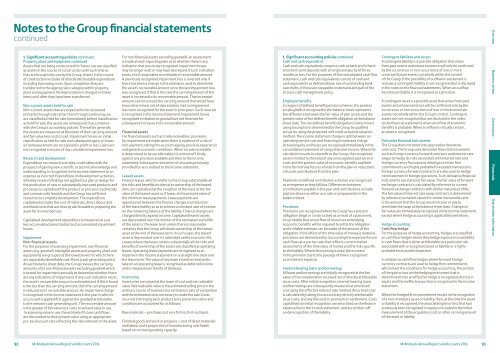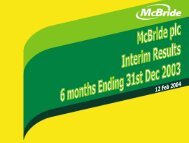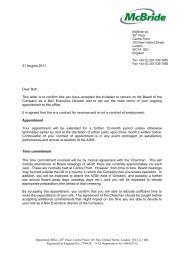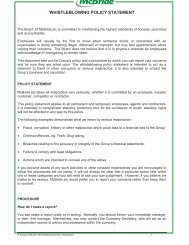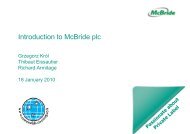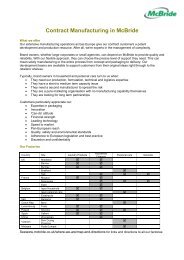pdf (2MB) - McBride
pdf (2MB) - McBride
pdf (2MB) - McBride
- No tags were found...
You also want an ePaper? Increase the reach of your titles
YUMPU automatically turns print PDFs into web optimized ePapers that Google loves.
Notes to the Group financial statementscontinued1. Significant accounting policies continuedProperty, plant and equipment continuedAssets that are being constructed for future use are classifiedas assets in the course of construction until such time asthey are brought into use by the Group. Assets in the courseof construction includes all directly attributable expenditureincluding borrowing costs. Upon completion they aretransferred to the appropriate category within property,plant and equipment. No depreciation is charged on theseitems until after they have been transferred.Non-current assets held for saleNon-current assets that are expected to be recoveredprimarily through sale rather than through continuing useare classified as held for sale. Immediately before classificationas held for sale, the assets are remeasured in accordancewith the Group’s accounting policies. Thereafter generallythe assets are measured at the lower of their carrying amountand fair value less costs to sell. Impairment losses on initialclassification as held for sale and subsequent gains or losseson remeasurement are recognised in profit or loss. Gains arenot recognised in excess of any cumulative impairment loss.Research and developmentExpenditure on research activities, undertaken with theprospect of gaining new scientific or technical knowledge andunderstanding, is recognised in the income statement as anexpense as incurred. Expenditure on development activities,whereby research findings are applied to a plan or design forthe production of new or substantially improved products andprocesses is capitalised if the product or process is technicallyand commercially feasible and the Group has sufficientresources to complete development. The expenditurecapitalised includes the cost of materials, direct labour andoverhead costs that are directly attributable to preparing theasset for its intended use.Capitalised development expenditure is measured at costless accumulated amortisation and accumulated impairmentlosses.ImpairmentNon-financial assetsFor the purposes of assessing impairment, non-financialassets (e.g. goodwill, intangible assets and property, plant andequipment) are grouped at the lowest levels for which thereare separately identifiable cash flows (cash generating units).At each balance sheet date, the Group reviews the carryingamounts of its non-financial assets excluding goodwill whichis tested for impairment annually to determine whether thereare any indications of impairment. If any such indication exists,the asset’s recoverable amount is estimated and if this is foundto be less than the carrying amount, then the carrying amountis reduced to its recoverable amount. An impairment chargeis recognised in the income statement in the year in which itoccurs and is applied first against the goodwill attributableto the relevant cash generating unit. The recoverable amountis the greater of fair value less costs to sell and value in use.In assessing value in use, the estimated future cash flowsare discounted to their present value using an appropriatepre-tax discount rate reflecting the risks inherent in the asset.For non-financial assets excluding goodwill, an assessmentis made at each reporting date as to whether there is anyindication that previously recognised impairment lossesmay no longer exist or may have decreased. If such indicationexists, the Group makes an estimate of recoverable amount.A previously recognised impairment loss is reversed only ifthere has been a change in the estimates used to determinethe asset’s recoverable amount since the last impairment losswas recognised. If that is the case the carrying amount of theasset is increased to its recoverable amount. That increasedamount cannot exceed the carrying amount that would havebeen determined, net of depreciation, had no impairmentloss been recognised for the asset in prior years. Such reversalis recognised in the income statement. Impairment lossesrecognised in relation to goodwill are not reversed forsubsequent increases in its recoverable amount.Financial assetsFor financial assets such as trade receivables, provisionsfor impairment are made when there is evidence of a risk ofnon-payment, taking into account ageing, previous experienceand general economic conditions. When a trade receivableis determined to be uncollectable it is written off, firstlyagainst any provision available and then to the incomestatement. Subsequent recoveries of amounts previouslyprovided for are credited to the income statement.Leased assetsFinance leases, which transfer to the Group substantially allthe risks and benefits incidental to ownership of the leaseditem, are capitalised at the inception of the lease at the fairvalue of the leased asset or, if lower, at the present value ofthe minimum lease payments. Lease payments areapportioned between the finance charges and reductionof the lease liability so as to achieve a constant rate of intereston the remaining balance of the liability. Finance charges arecharged directly against income. Capitalised leased assetsare depreciated over the shorter of the estimated useful lifeof the asset or the lease term unless there is reasonablecertainty that the Group will obtain ownership of the leasedasset at the end of the lease term. In such cases, the leasedasset is depreciated over its estimated useful economic life.Leases where the lessor retains substantially all the risks andbenefits of ownership of the assets are classified as operatingleases. Operating lease payments are recognised as anexpense in the income statement on a straight-line basis overthe lease term. The value of any lease incentive received totake on an operating lease is recognised as deferred incomeand is released over the life of the lease.InventoriesInventories are valued at the lower of cost and net realisablevalue. Net realisable value is the estimated selling price in theordinary course of business less estimated costs of completionand the estimated costs necessary to make the sale. Costsincurred in bringing each product to its present location andcondition are accounted for as follows:Raw materials – purchase cost on a first-in, first-out basis.Finished goods and work in progress – cost of direct materialsand labour and a proportion of manufacturing overheadsbased on normal operating capacity.1. Significant accounting policies continuedCash and cash equivalentsCash and cash equivalents comprise cash at bank and in handand short-term deposits with an original maturity of threemonths or less. For the purposes of the consolidated cash flowstatement, cash and cash equivalents consist of cash andcash equivalents as defined above, net of outstanding bankoverdrafts, if these are repayable on demand and part of theGroup’s cash management policy.Employee benefitsIn respect of defined benefit pension schemes, the pensionsurplus/deficit recognised in the balance sheet representsthe difference between the fair value of plan assets and thepresent value of the defined benefit obligation at the balancesheet date. The net defined benefit obligation is determinedusing assumptions determined by the Group by qualifiedactuaries using the projected unit credit actuarial valuationmethod. The income statement charge is split between anoperating service cost and financing income and charge.Actuarial gains and losses are recognised immediately in theconsolidated statement of comprehensive income. When thecalculation results in a benefit to the Group, the recognisedasset is limited to the total of any unrecognised past servicecosts and the present value of economic benefits availablein the form of any future refunds from the plan or reductionsin future contributions from the plan.Payments to defined contribution schemes are recognisedas an expense as they fall due. Differences betweencontributions payable in the year and contributions actuallypaid are shown as either accruals or prepayments in thebalance sheet.ProvisionsProvisions are recognised when the Group has a presentobligation (legal or constructive) as a result of a past event,it is probable that an outflow of resources embodyingeconomic benefits will be required to settle the obligationand a reliable estimate can be made of the amount of theobligation. If the effect of the time value of money is material,provisions are determined by discounting the expected futurecash flows at a pre-tax rate that reflects current marketassessments of the time value of money and the risks specificto the liability. Where discounting is used, the increasein the provision due to the passage of time is recognisedas an interest expense.Interest-bearing loans and borrowingsAll loans and borrowings are initially recognised at the fairvalue of the consideration received net of directly attributableissue costs. After initial recognition, interest-bearing loansand borrowings are subsequently measured at amortisedcost using the effective interest rate method. Amortised costis calculated by taking into account any directly attributableissue costs, and any discount or premium on settlement. Costscapitalised on initial recognition are amortised on the financeexpense line in the income statement, and are written-offon derecognition of the liability.Contingent liabilities and assetsA contingent liability is a possible obligation that arisesfrom past events and whose existence will only be confirmedby the occurrence or non-occurrence of one or moreuncertain future events not wholly within the controlof the Group. If the possibility of outflow in settlement isremote, a contingent liability is not recognised but is disclosedin the notes to the financial statements. When an outflowbecomes probable, it is recognised as a provision.A contingent asset is a possible asset that arises from pastevents and whose existence will be confirmed only by theoccurrence or non-occurrence of one or more uncertainevents not wholly within the Group’s control. Contingentassets are not recognised but are disclosed in the notesto the financial statements when an inflow of economicbenefits is probable. When an inflow is virtually certain,an asset is recognised.Derivative financial instrumentsThe Group does not enter into speculative derivativecontracts. The Group uses derivative financial instrumentssuch as foreign currency forward contracts and interest rateswaps to hedge its risks associated with interest rate andforeign currency fluctuations relating to certain firmcommitments and highly probable forecasted transactions.Foreign currency forward contracts are also used to hedgenet investment in foreign operations. Such derivative financialinstruments are stated at fair value. The fair value of forwardexchange contracts is calculated by reference to currentforward exchange contracts with similar maturity profiles.The fair value of interest rate swap contracts is determinedby reference to market values for similar instruments andis the amount that the Group would receive or pay toterminate the swap at the balance sheet date. Changes infair value are immediately recognised in the income statementexcept where hedge accounting is applicable (see below).Hedge accountingCash flow hedgeFor the purposes of hedge accounting, hedges are classifiedas cash flow hedges where they hedge exposure to variabilityin cash flows that is either attributable to a particular riskassociated with a recognised asset or liability or a highlyprobable forecasted transaction.In relation to cash flow hedges where forward foreigncurrency contracts are used to hedge firm commitmentswhich meet the conditions for hedge accounting, the portionof the gain or loss on the hedging instrument that isdetermined to be an effective hedge is recognised directly inequity and the ineffective portion is recognised in the incomestatement.When the hedged firm commitment results in the recognitionof a non-monetary asset or liability, then, at the time the assetor liability is recognised, the associated gain or loss that hadpreviously been recognised in equity is included in the initialmeasurement of the acquisition cost or other carrying amountof the asset or liability.Overview Business review Governance Financials Shareholder information92 <strong>McBride</strong> plc Annual Report and Accounts 2011 <strong>McBride</strong> plc Annual Report and Accounts 2011 93


